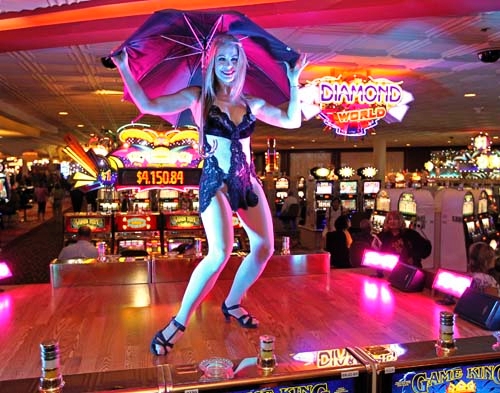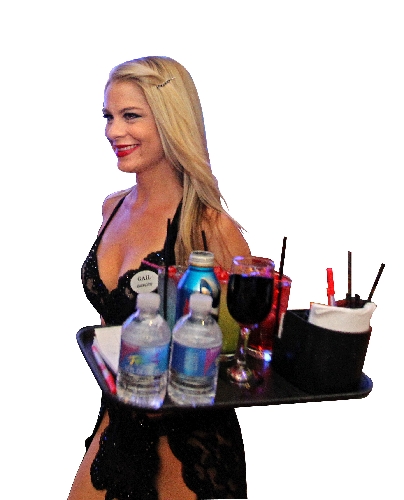Bevertainer serves cocktails and dances
When dancer Gail VanDervoort landed a gig as a bevertainer at the Rio, she worried about those things that concern most performers starting a new show.
Would she remember the choreography? Would she have the energy to perform eight numbers during her shift? Would she be a good dancer?
A few hours into her first shift, all those worries were pushed aside, replaced by a new one: Would she be able to serve cocktails?
"I didn't think it was so physically demanding," VanDervoort, 42, recalls. "From a performing aspect, you're concerned about that first and then you realize that comes naturally, because you've been trained for it. The hard part is the serving."
When VanDervoort started her bevertainer job seven years ago, the concept -- to have professional dancers and singers serve cocktails -- was still new to both the Rio and Las Vegas.
Some performers dismissed the idea outright; cocktail serving was something to do when you couldn't land a gig. People thought it wouldn't last, says Maureen Myers, director for Dick Foster Productions, which runs the bevertainer program.
It has turned out to be wildly successful for the Rio, Myers says. The program will mark its eighth year this month.
"The guests really love it, they have a lot of fun with it," Myers says. "We have a lot of repeat business because of it."
VanDervoort is one of 85 bevertainers -- some singers, some dancers -- who serve the casino floor daily. Over the years, she has built up a loyal following, Myers says.
"She's the kind of person you'd love if you met her. She's great with her guests and she's a very reliable performer. Gail is one of those people you wish you could clone," Myers says.
Among local performers, bevertaining has become a sought-after job because they can get paid to do what they love, VanDervoort says.
"When I first came to Las Vegas, there were a lot of little shows around but it was really difficult to get into those shows," VanDervoort says. "I wish I had this option back then."
A California native, VanDervoort moved to Las Vegas in 1994 with her husband and two daughters who are now 19 and 22 years old. She had been working as a professional dancer since the age of 18, touring Japan with a dance troupe before marrying her husband, a stage technician. They moved here to work with the "Melinda -- First Lady of Magic" show. For 18 months, VanDervoort danced and served as a magician's assistant while her husband did pyrotechnics for the touring magic show. Their daughters even had small roles in the act.
Eventually, the traveling and home-schooling became too difficult, so the family settled in Las Vegas. After taking a couple of years off to be a mom, VanDervoort got back into performing in 1997 at Caesars Magical Empire in a Dick Foster production. She worked as a wizard, performing magic tricks while people ate dinner. It was easy for the family, too, because producers let her bring the kids to work, she says.
The venue closed in 2002 to make way for a nightclub, thus ending VanDervoort's magic career. About a year later, she called up Dick Foster Productions and asked to audition for the new bevertainer program at the Rio.
An old Vegas myth, that you have to know someone to get a job serving cocktails in a casino, is dispelled by the bevertainers' casting methods. Each person auditions for his or her role, Myers says. They always look for talent, because it's easier to teach serving cocktails than performing. Still, many people tend to underestimate the difficulty of a cocktail serving job, she adds.
"It's a very rewarding job financially but it does take a toll on the body," Myers says.
Though she didn't give an exact amount, VanDervoort says her income bought one daughter a car and will fund both of their educations.
In her first days as a bevertainer, VanDervoort learned that cocktail serving requires balance, strength and an ability to think on her feet.
"You can have as much balance in ballet but it's a different thing holding a tray on one side," VanDervoort says. "All of us have had our share of dropped trays and saying, 'Oh, I'm so sorry.' "
To make things easier for the bevertainers, they're limited to carrying about 13 drinks at a time, Myers says. But that rule sometimes is broken on busy days, such as New Year's Eve or Super Bowl Sunday. Then, they might carry as many as 23 drinks, making the tray weigh more than 20 pounds.
VanDervoort uses Pilates to stay in shape, which not only helps her with work, it's also a requirement of the job. Every so often, bevertainers are weighed in and are expected to maintain the level of fitness they had when they were hired, Myers says.
Every hour, bevertainers must do a 90-second individual performance on one of five stages throughout the casino. If VanDervoort is too busy to dance, a co-worker can cover a performance, although that rarely happens. No matter what, customer service takes precedence over the performing.
"Sometimes, you're walking around and thinking you're going to go do a dance. Then someone will say, 'Can I have a rum and Coke?' You have to make sure you get that drink before you do your dance," VanDervoort says.
The bevertainers must adhere to a couple of strict policies. When someone orders a drink, they must tell the guest they will return with it in five to seven minutes, VanDervoort says. If they don't order a drink, they must tell guests that they will return in 15 minutes to ask again.
The most popular drink ordered, VanDervoort says, is a Bloody Mary. The most difficult drink to make? A cup of tea with honey.
Since she doesn't drink much, it took VanDervoort a couple of weeks to understand cocktails. People have asked for some wild things, she says. One of the most unusual orders she took was for a rum with a cold pack.
"I said to the bartender, 'What's a cold pack?' thinking it was some mix I hadn't heard of. And he said, 'You mean a Coke, back?' " VanDervoort says, referring to an order for rum with a Coke chaser.
Even after seven years on the job, VanDervoort is occasionally surprised by guests. Sometimes, a customer reaches out and grabs a drink off her tray, thinking they're helping. But that sudden movement can cause spilled drinks and dropped trays.
The bevertainer costumes are a major source of surprise, too. They're so distinctively designed that people have been known to pull her skirt up to get a closer look.
"I tell them that I wouldn't lift their skirt up, so they shouldn't lift mine," VanDervoort says.
As unusual as it seemed in the beginning, bevertaining has been a great job for her, VanDervoort says. She gets to perform, earn a steady paycheck and have free time to pursue other things. She works three eight-hour shifts a week; most bevertainers don't work full time, Myers notes. And she enjoys her role as a sort of mentor to some of the younger bevertainers who are just starting their performing careers.
"There's kind of a camaraderie that I can't put my finger on," VanDervoort says. "For me, it's fun. I've done the shows and the traveling, so when the younger ones come in, it's fun to give them words of wisdom."
Contact reporter Sonya Padgett at spadgett@ reviewjournal.com or 702-380-4564.






























